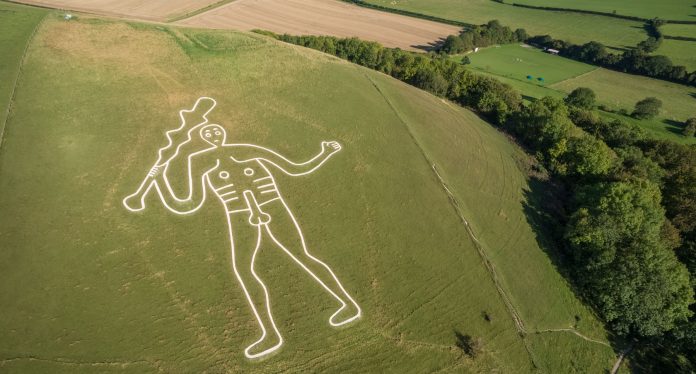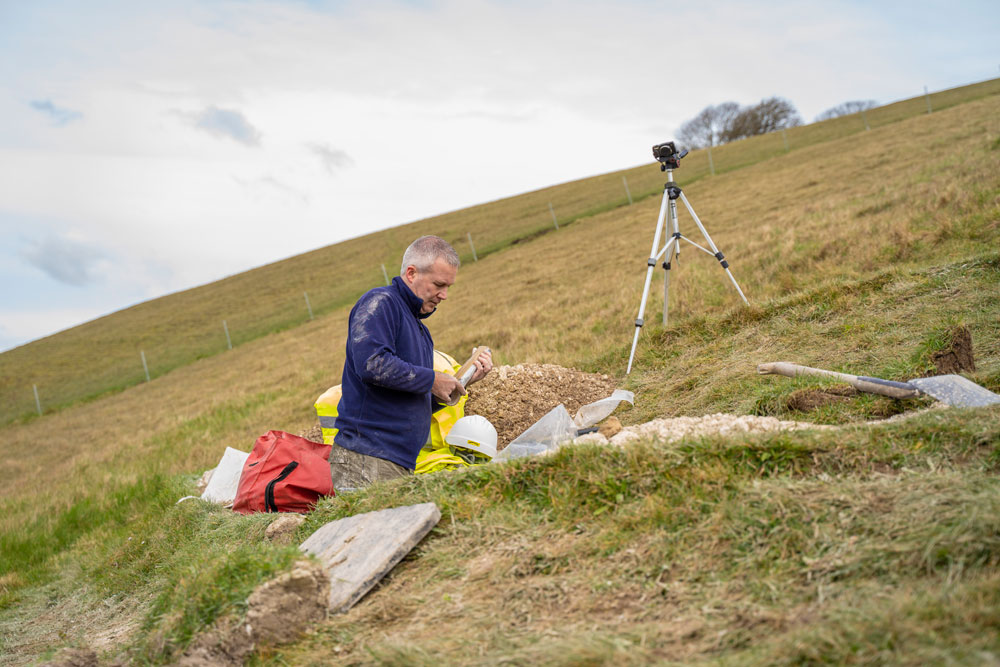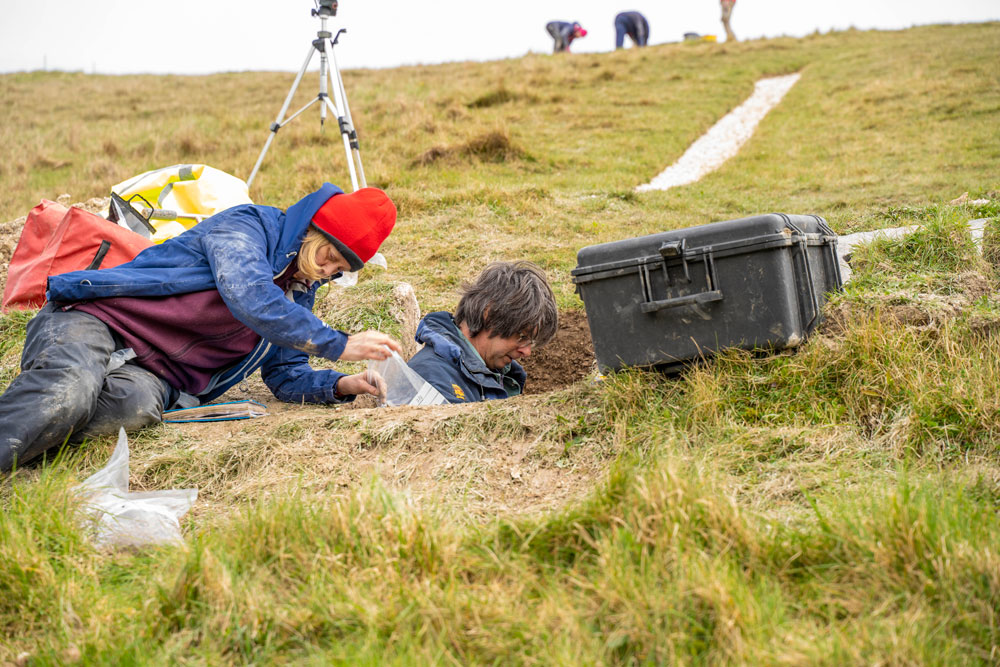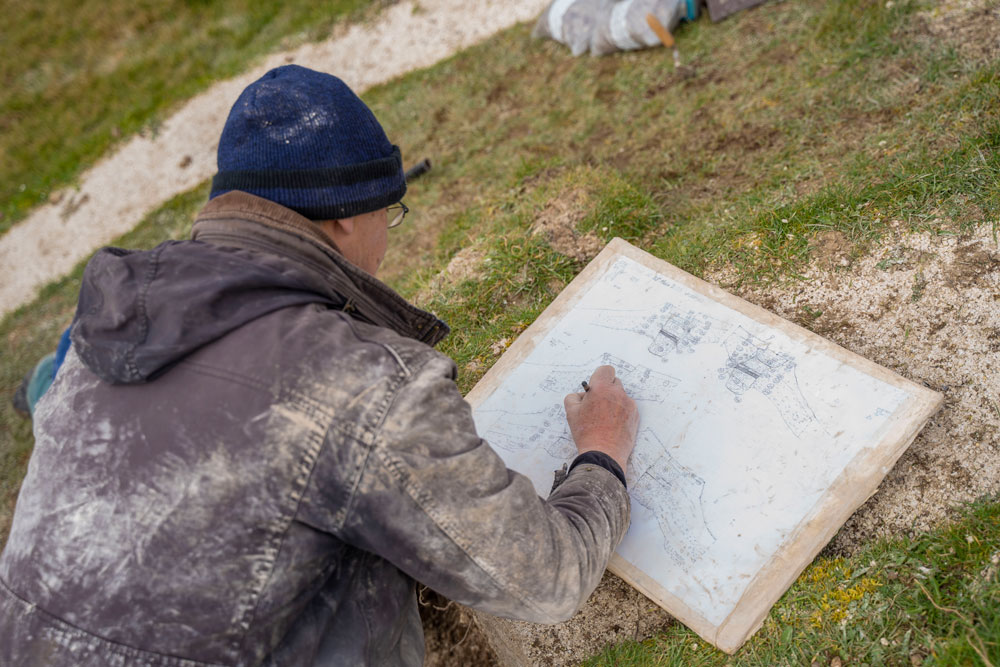Header : Cerne Abbas giant from the air. National Trust Images: Mike Calnan James Dobson
National Trust archaeologists are surprised and delighted by likely age of enigmatic Cerne Giant – but some mystery still remains
After 12 months of scientific analysis, the National Trust can for the first time reveal the likely age of the Cerne Giant, Britain’s largest and perhaps best-known chalk hill figure.
Generations have speculated about the age and meaning of the club-brandishing giant hewn into a Dorset hillside. Was he a depiction of the legendary demi-god Hercules, an ancient fertility symbol, or even the soldier and statesman Oliver Cromwell? Another theory holds that the figure was carved around the body of a giant who was slain by local people after he terrorised the countryside.
Now, after state-of-the art sediment analysis jointly funded by the National Trust, the University of Gloucestershire, Allen Environmental Archaeology and the Pratt Bequest, National Trust archaeologists have concluded the giant was probably first constructed in the late Saxon period.
Independent geoarchaeologist Mike Allen, whose research is helping the Trust understand more about the landscape in which the giant was created, said the result was surprising.
‘This is not what was expected. Many archaeologists and historians thought he was prehistoric or post-medieval, but not medieval. Everyone was wrong, and that makes these results even more exciting.’
Phillip Toms, Professor in Physical Geography at the University of Gloucestershire, studied the samples using Optically Stimulated Luminescence (OSL), which shows when individual grains of sand in the sediment were last exposed to sunlight. Material taken from the deepest layer (1m) yielded a date range of 700-1100AD which suggests the giant was first made by late Saxons.
National Trust senior archaeologist Martin Papworth said: “The archaeology on the hillside was surprisingly deep – people have been re-chalking the giant over a long period of time. The deepest sample from his elbows and feet tells us he could not have been made before 700AD, ruling out theories that he is of prehistoric or Roman origin.
‘This probable Saxon date places him in a dramatic part of Cerne history. Nearby Cerne Abbey was founded in 987AD and some sources think the abbey was set up to convert the locals from the worship of an early Anglo Saxon god known as ‘Heil’ or ‘Helith’. The early part of our date range does invite the question, was the giant originally a depiction of that god?’
But other samples – taken with permission from Historic England and the Secretary of State – gave later dates of up to 1560, which presented Martin and his team with a conundrum, because the earliest documented record of the giant is a church warden’s account of repairing him in 1694.
‘The science suggests he could be medieval, but intriguingly, surviving documents from Cerne Abbey don’t mention the giant. In the 16th century it’s as if the giant’s not there, and John Norden’s survey of 1617 makes no mention of him. And why would a rich and famous abbey – just a few yards away – commission, or sanction, a naked man carved in chalk on the hillside?’
Martin’s working theory is that the giant may have been a medieval creation but then – for reasons we may never know – was neglected for several hundred years, before being rediscovered.
‘I wonder whether he was created very early on, perhaps in the late Saxon period, but then became grassed over and was forgotten. But at some stage, in low sunlight, people saw that figure on the hill and decided to re-cut him again. That would explain why he doesn’t appear in the abbey records or in Tudor surveys.’
This is consistent with Mike Allen’s research, which found that microscopic snails in the sediment samples included species that were introduced into Britain in the medieval period. The archaeological fieldwork and scientific study, however, found no archaeological evidence that the giant was deliberately covered over.
Gordon Bishop, Chair of the Cerne Historical Society, said: ‘These results are intriguing as well as surprising. What I am personally pleased about is that the results appear to have put an end to the theory that he was created in the 17th century as an insult to Oliver Cromwell. I thought that rather demeaned the giant.
‘In fact it seems highly likely that he had a religious significance, albeit a pagan one. There’s obviously a lot of research for us to do over the next few years.’
Mike Allen added that the results had shed light more broadly on the phenomenon of chalk hill figures in Britain.
‘Archaeologists have wanted to pigeonhole chalk hill figures into the same period. But carving these figures was not a particular phase – they’re all individual figures, with local significance, each telling us something about that place and time.’
He said the Trust’s careful management of the figure, which was gifted by the Pitt-Rivers family in 1920, had enabled the giant’s true age to be revealed.
‘The dating of the giant was only possible because the National Trust has preserved and maintained the figure, which otherwise might have been lost to history.’
Martin Papworth continued: ‘To narrow down a date for him is a great thing to achieve, and we’re closer now. Future research could tell us even more about how he changed over time, and whether our theory about his ‘lost’ years is true.
‘When we began the work, some people wanted the giant’s age to remain a mystery – but archaeologists want to use science to seek answers. We have nudged our understanding a little closer to the truth but he still retains many of his secrets. He still does have an air of mystery, so I think everyone’s happy.’
More information is available on www.nationaltrust.org.uk/cerne-giant




